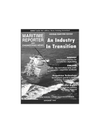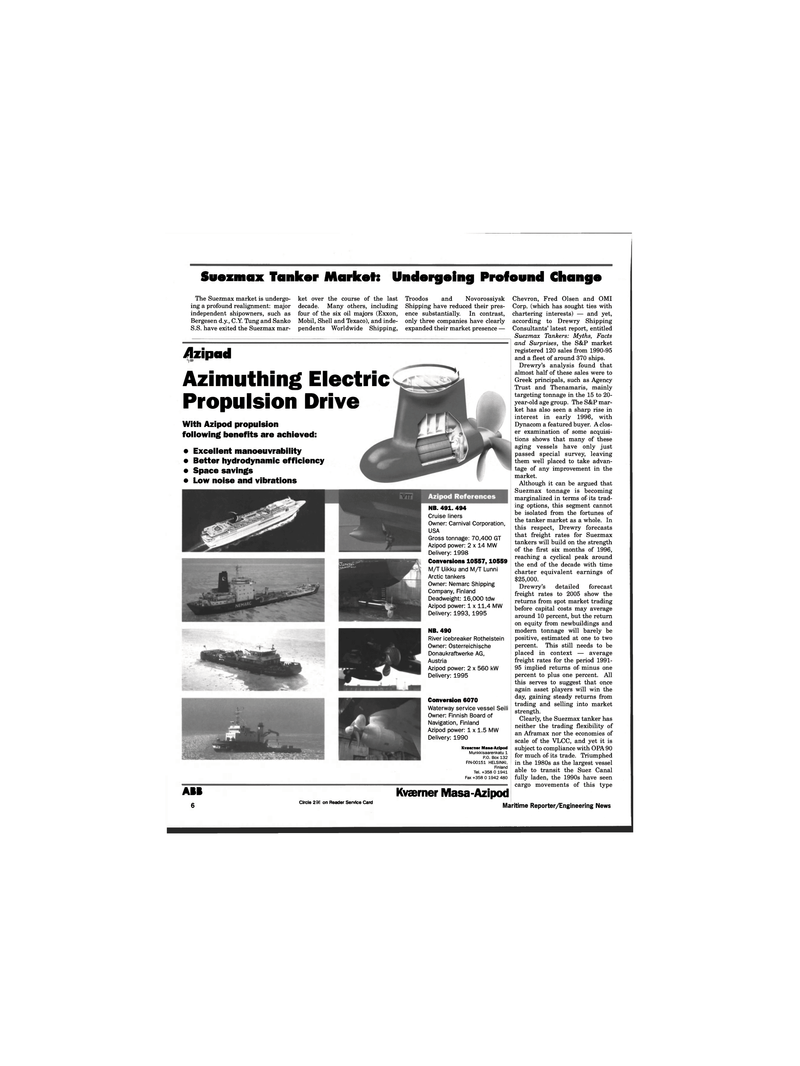
Page 4: of Maritime Reporter Magazine (September 1996)
Read this page in Pdf, Flash or Html5 edition of September 1996 Maritime Reporter Magazine
Suezmax Tanker Market: Undergeing Profound Change
The Suezmax market is undergo- ing a profound realignment: major independent shipowners, such as
Bergesen d.y., C.Y. Tung and Sanko
S.S. have exited the Suezmax mar- ket over the course of the last decade. Many others, including four of the six oil majors (Exxon,
Mobil, Shell and Texaco), and inde- pendents Worldwide Shipping,
Troodos and Novorossiysk
Shipping have reduced their pres- ence substantially In contrast, only three companies have clearly expanded their market presence — /Izipad
Azimuthing Electric
Propulsion Drive
With Azipod propulsion following benefits are achieved: • Excellent manoeuvrability • Better hydrodynamic efficiency • Space savings • Low noise and vibrations
NB. 491. 494
Cruise liners
Owner: Carnival Corporation,
USA
Gross tonnage: 70,400 GT
Azipod power: 2 x 14 MW
Delivery: 1998
Conversions 10557,10559
M/T Uikku and M/T Lunni
Arctic tankers
Owner: Nemarc Shipping
Company, Finland
Deadweight: 16,000 tdw
Azipod power: 1 x 11,4 MW
Delivery: 1993, 1995
NB. 490
River icebreaker Rothelstein
Owner: Osterreichische
Donaukraftwerke AG,
Austria
Azipod power: 2 x 560 kW
Delivery: 1995
Conversion 6070
Waterway service vessel Seili
Owner: Finnish Board of
Navigation, Finland
Azipod power: 1 x 1.5 MW
Delivery: 1990
Kvaerner Masa-Azipod
Munkkisaarenkatu 1
P.O. Box 132
FIN-00151 HELSINKI,
Finland
Tel. +358 0 1941
Fax +358 0 1942 480
ABB 6
Chevron, Fred Olsen and OMI
Corp. (which has sought ties with chartering interests) — and yet, according to Drewry Shipping
Consultants' latest report, entitled
Suezmax Tankers: Myths, Facts and Surprises, the S&P market registered 120 sales from 1990-95 and a fleet of around 370 ships.
Drewry's analysis found that almost half of these sales were to
Greek principals, such as Agency
Trust and Thenamaris, mainly targeting tonnage in the 15 to 20- year-old age group. The S&P mar- ket has also seen a sharp rise in interest in early 1996, with
Dynacom a featured buyer. A clos- er examination of some acquisi- tions shows that many of these aging vessels have only just passed special survey, leaving them well placed to take advan- tage of any improvement in the market.
Although it can be argued that
Suezmax tonnage is becoming marginalized in terms of its trad- ing options, this segment cannot be isolated from the fortunes of the tanker market as a whole. In this respect, Drewry forecasts that freight rates for Suezmax tankers will build on the strength of the first six months of 1996, reaching a cyclical peak around the end of the decade with time charter equivalent earnings of $25,000.
Drewry's detailed forecast freight rates to 2005 show the returns from spot market trading before capital costs may average around 10 percent, but the return on equity from newbuildings and modern tonnage will barely be positive, estimated at one to two percent. This still needs to be placed in context — average freight rates for the period 1991- 95 implied returns of minus one percent to plus one percent. All this serves to suggest that once again asset players will win the day, gaining steady returns from trading and selling into market strength.
Clearly, the Suezmax tanker has neither the trading flexibility of an Aframax nor the economies of scale of the VLCC, and yet it is subject to compliance with OPA 90 for much of its trade. Triumphed in the 1980s as the largest vessel able to transit the Suez Canal fully laden, the 1990s have seen cargo movements of this type
Circle 203 on Reader Service Card
Kvaerner Masa-Azipod
Maritime Reporter/Engineering News

 3
3

 5
5
